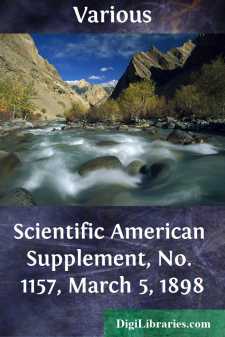Categories
- Antiques & Collectibles 13
- Architecture 36
- Art 48
- Bibles 22
- Biography & Autobiography 813
- Body, Mind & Spirit 142
- Business & Economics 28
- Children's Books 16
- Children's Fiction 13
- Computers 4
- Cooking 94
- Crafts & Hobbies 4
- Drama 346
- Education 46
- Family & Relationships 57
- Fiction 11829
- Games 19
- Gardening 17
- Health & Fitness 34
- History 1377
- House & Home 1
- Humor 147
- Juvenile Fiction 1873
- Juvenile Nonfiction 202
- Language Arts & Disciplines 88
- Law 16
- Literary Collections 686
- Literary Criticism 179
- Mathematics 13
- Medical 41
- Music 40
- Nature 179
- Non-Classifiable 1768
- Performing Arts 7
- Periodicals 1453
- Philosophy 64
- Photography 2
- Poetry 896
- Political Science 203
- Psychology 42
- Reference 154
- Religion 513
- Science 126
- Self-Help 84
- Social Science 81
- Sports & Recreation 34
- Study Aids 3
- Technology & Engineering 59
- Transportation 23
- Travel 463
- True Crime 29
Lippincott's Magazine, Vol. 22, November, 1878 of Popular Literature and Science
by: Various
Description:
Excerpt
IT is not by any means certain what was the name by which Long Island was known to the aboriginal dwellers in its "forest primeval," or indeed that they ever had a common name by which to designate it. It seems probable that each tribe bestowed upon it a different name, expressive of the aspect that appeared most striking to its primitive and poetical visitors and occupants. Among so many tribes—the Canarsees (who met Hudson when on September 4, 1609, he anchored in Gravesend Bay), the Rockaways, Nyacks, Merrikokes, Matinecocs, Marsapeagues, Nissaquages, Corchaugs, Setaukets, Secataugs, Montauks, Shinecocs, Patchogues, and Manhansetts, to say nothing of the Pequots and Narragansetts on the northern shore of the Sound—a community of usage in regard to nomenclature could hardly be expected. We accordingly find that one of the old names of the island was Mattenwake, a compound of Mattai, the Delaware for "island." It was also called Paumanacke (the Indian original of the prosaic Long Island), Mattanwake (the Narragansett word for "good" or "pleasant land"), Pamunke and Meitowax. For a name, however, at once beautiful and suggestive, appropriate to an island whose sunny shores are strewn with shells, and recalling Indian feuds and customs, savage ornament and tributes paid in wampum, no name equals that we have chosen—Seawanhaka or Seawanhackee, the "Island of Shells."
No general description will give an adequate idea of its changing beauty and wellnigh infinite variety. Its scenery assumes a thousand different aspects between odoriferous Greenpoint and the solitary grandeur of Montauk. If one could only recall the old stagecoach, and, instead of whirling in a few hours from New York to Sag Harbor, creep slowly along the southern shore, and complete the journey of one hundred and ten miles in two days and a half, as they did fifty years ago, a description of the route would be both easy and interesting. Then the old stage lumbered out of Brooklyn about nine o'clock in the morning, a halt was made at Hempstead for dinner, and at Babylon the passengers slept. Starting early, they arrived in due time at Patchogue, where they breakfasted late, and thereby saved their dinner, and at Quogue, about twenty-four miles farther, they supped and slept. Again making an early start without breakfast, they jogged along to Southampton, where the morning meal was taken, and thus fortified they returned to their seats, and, passing through the beautiful country lying around Water Mill and Bridgehampton, rattled into Sag Harbor—a far different place from the Sag Harbor of to-day—and there dined. Fortunately, the rest of the route remains to us, and we can still "stage it" down the old and beautiful road to Easthampton. A leisurely journey of this description, at an average rate of a fraction less than two miles an hour, and with abundant opportunity of getting out for a brisk walk as the horses dragged their cumbrous load over an occasional sandhill, gave the traveller a chance of seeing the country he passed through. Long Island lay before him like a book, every line of which he could read at leisure. He could wander along the shore of the bay at Babylon, and mayhap meditate upon the beauty of Nature while looking at the moonlight sleeping on the water: he could at Quogue seek his way across the meadows and gaze upon the troubled face of the ocean. We can do so still, but these pleasures are no longer to be counted among the fascinating interludes of continuous travel. They are not the accompaniments of a long journey that gave it a flavor of romance, and made a trip to Sag Harbor and return the employment of an eventful and delightful week.
To adapt ourselves to modern conditions, and as we must view Long Island in sections to appreciate it as a whole, a route may be chosen in which, by using both railroad and stage, we may see even more of it, and that to greater advantage, than the old-time traveller. It is necessary, in the first place, that something should be seen of the northern shore. In character and associations it differs widely from the southern. There is, in the second place, the central section, in avoiding which much of the rural and most placid beauty of the island would be lost. There is, thirdly, the southern shore, varied in itself according as the point at which it is viewed lies on the ocean or on the landlocked bays between Hempstead and Mecoc, and extending to the rugged headland of Montauk....












